
This article was originally published on July 26, 2022 on The Restless Viking website.
The Alto Active Achievers Community Club brought Lowell’s history to life last weekend along the banks of the Grand River. This professionally executed production, sponsored by the Lowell Area Historical Society, and had a cast of 42 youngsters and several dedicated adults. The authentic story held strength, perseverance, loyalty and love. Then, betrayal and heartbreak. As white settlers built their homes on the Odawa land, they renamed the village, “Lowell.” Join me for this incredible presentation of history which was cleverly written by Heidi Kaeb Stoller.
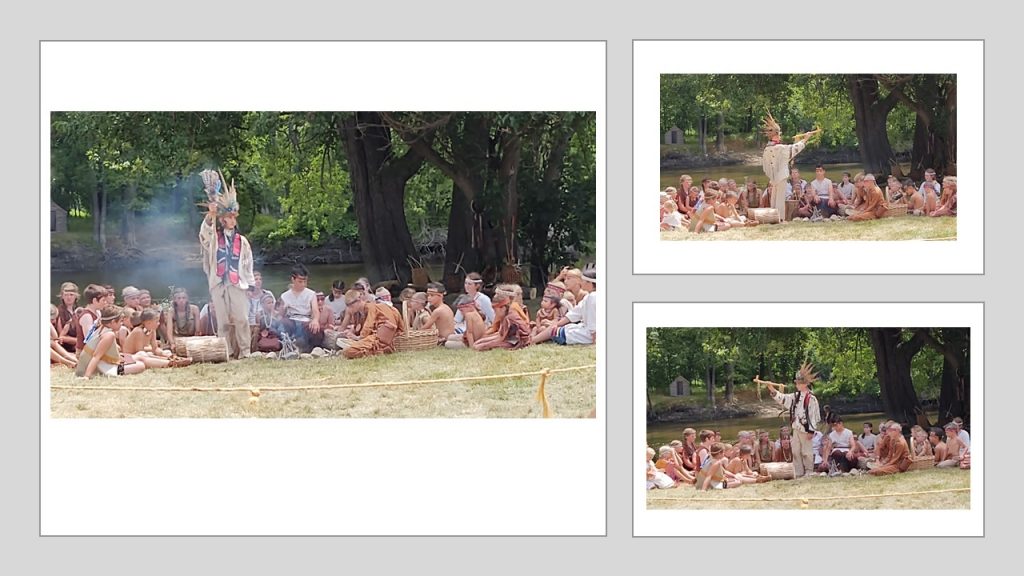 Chief Wabwindego paid homage to the north, south, east and west as the tribe began a council meeting.
Chief Wabwindego paid homage to the north, south, east and west as the tribe began a council meeting.The 400 Odawa had lived harmoniously with nature along the banks of the Grand River.
The Alto Active Achievers Club began learning native history last September. Many of their leather work projects, which were worn for the production, will be on display at the Kent County Youth Fair next month. (August 2022) The group also practiced customs and ate tribal food as part of their preparation.
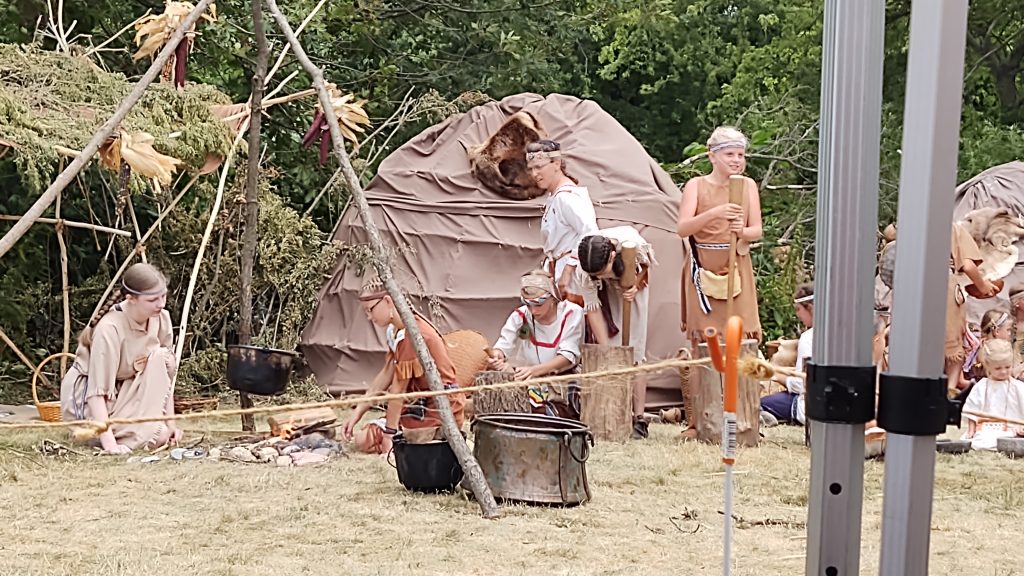
Activity abounded around the Odawa camp.
Each person had a job to do to keep the community running smoothly.
Earlier in the week the children had constructed the wigwams and fire pit.
As a former elementary teacher my eyes got misty. I was witnessing formative lessons which would be imprinted on this generation.
Madame La Framboise
Joseph La Framboise and his wife, Magdelaine, opened a trading post along the Grand River in 1795. This was the first permanent mercantile building in western Michigan. At 15 years old, Magdelaine was fluent in Odawa, French, English and Ojibwe. The couple were devout Catholics. Sadly, Joseph was murdered in 1806. Madame La Framboise continued to mind the trading post. She was trusted among the tribes in the region and sustained her regular trading route to and from Mackinac Island.
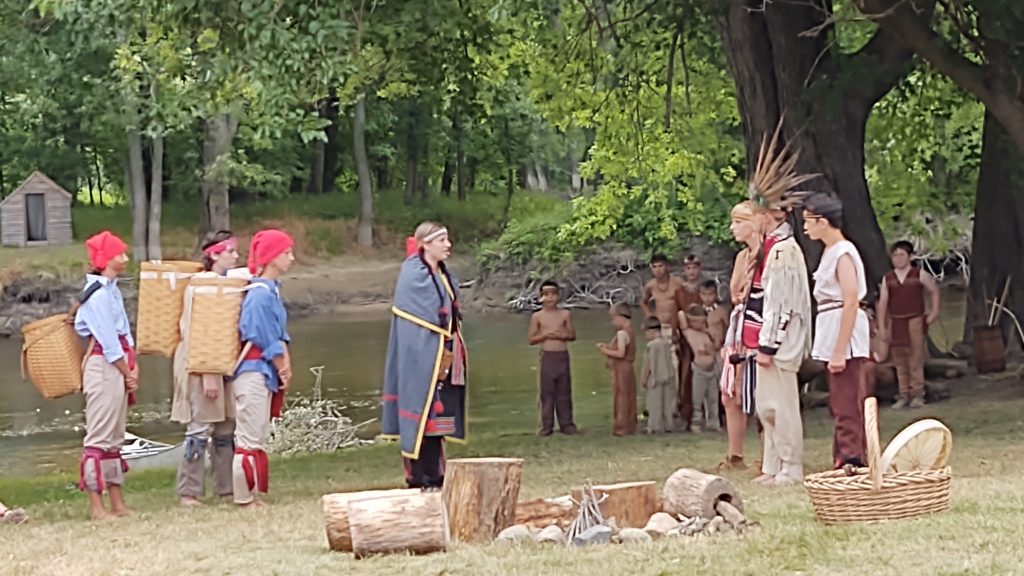
Madame La Frambroise respectfully traded with the Odawa tribe.
Two actors held a third who was squirming and whining. Nequat, a native accused of murdering Joseph La Framboise, was captured and brought to Madame LaFramboise. “With many prayers,” Madame LaFramboise forgave him and allowed him to go free. Nequat ran off to live alone in the woods.
The boy playing the part of Nequat RAN and disappeared quickly to the left. The narrator spoke, “Without a community to belong to as well as the weighing guilt, he sadly took his own life.” Across the river Nequat reappeared and fell on an imaginary knife. (“How did he get over to the other shore so quickly?” I wondered.)
Rix Robinson acquired the rights to Madame’s trading post in 1821. Madame La Framboise moved to Mackinac Island and began a Catholic school for native children. She retired on the island. Madame La Framboise passed away on April 4, 1846. Her body was interred beneath the altar of Ste. Anne’s church. Later, upon renovations to the church, her body, along with her two daughters, was placed in Ste. Anne’s churchyard with a historical marker.
Daniel Marsac
Right on cue a canoe swirled to shore expertly steered by youngsters. It was an amazing display of skill! With his sister marrying Louie Campau in Grand Rapids, Daniel Marsac had made his way east along the Grand River with French explorers and fur traders. Chief Wabwindego welcomed Daniel, who became a part of the Odawa community. Daniel Marsac was the first white settler in the area.
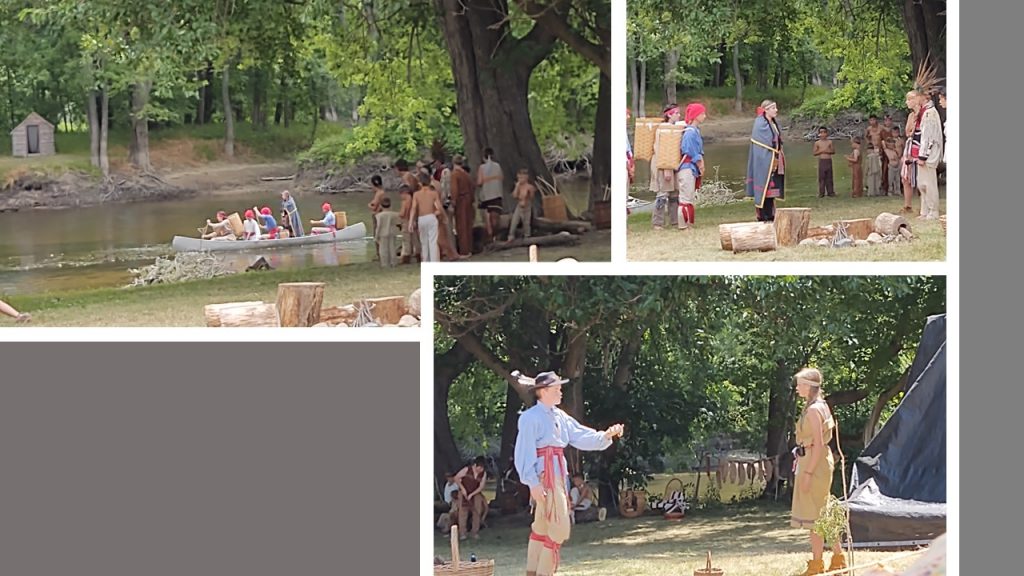
Daniel Marsac, a French fur trader, was entranced with Jenute, a young tribe member, upon his 1829 arrival.
After many denials, Jenute, an Odawa lady, finally agreed to marry Daniel Marsac.
The wedding celebration included dancing and feasting. Fresh popcorn was heated over the fire by two actresses. (bottom left photo below) The youngest actors seemed to thoroughly enjoy their snack eaten from wooden bowls.
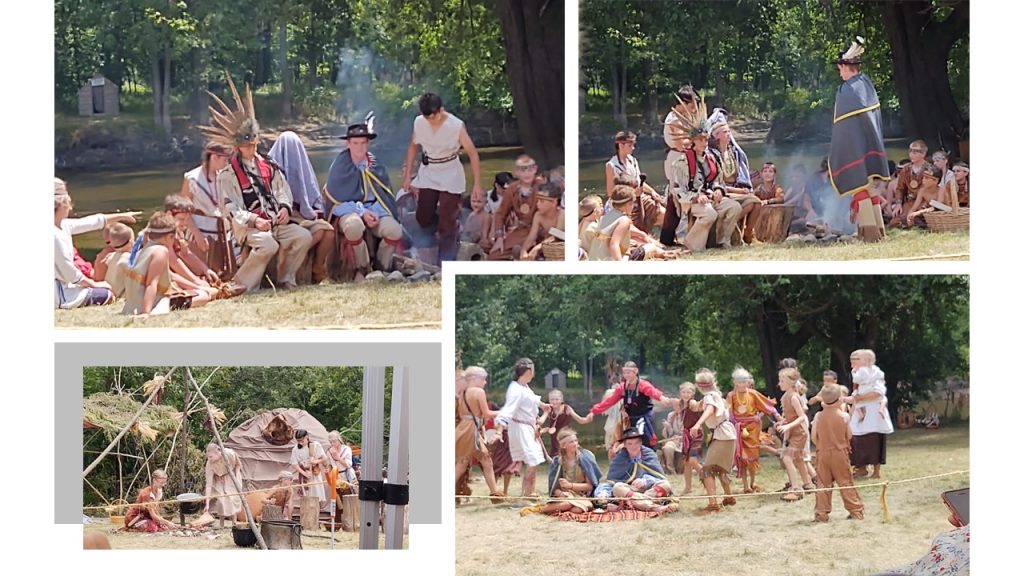
Daniel Marsac opened a trading post across the river in 1831 and named the settlement, “Dansville.” The couple became parents to a baby girl, Marie.
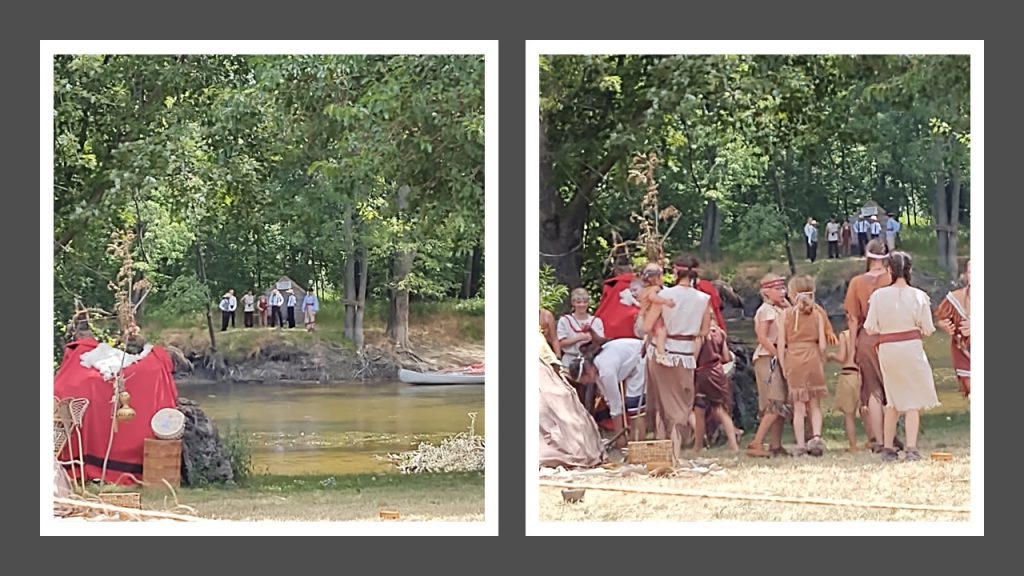
These young thespians skillfully maneuvered canoes across the rushing river to Daniel Marsac’s trading post. Characters could easily be heard. Thank you to John and Jill Wenger who provided the sound system.
As Marie grew, Daniel wanted his daughter to learn French customs and took her to his Detroit home. Jenute was heartbroken.
Settlers Arrive
Alva Jones, Lewis Robinson, Philander Tracy and Sylvester Hodges traveled by boat from Scipio, New York. With more people arriving in 1836, new viruses were brought to the area.
Settlers built log homes and a sawmill as smartly noted by the cardboard props.
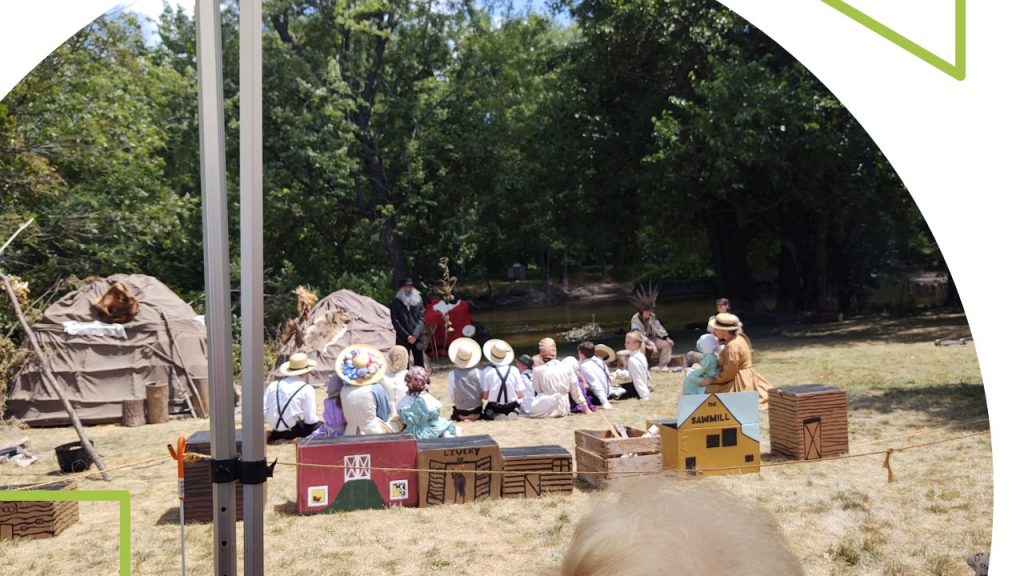
Reverend Freize (bearded character dressed in black) would travel
by Odawa footpaths to bring the word of God to villagers.
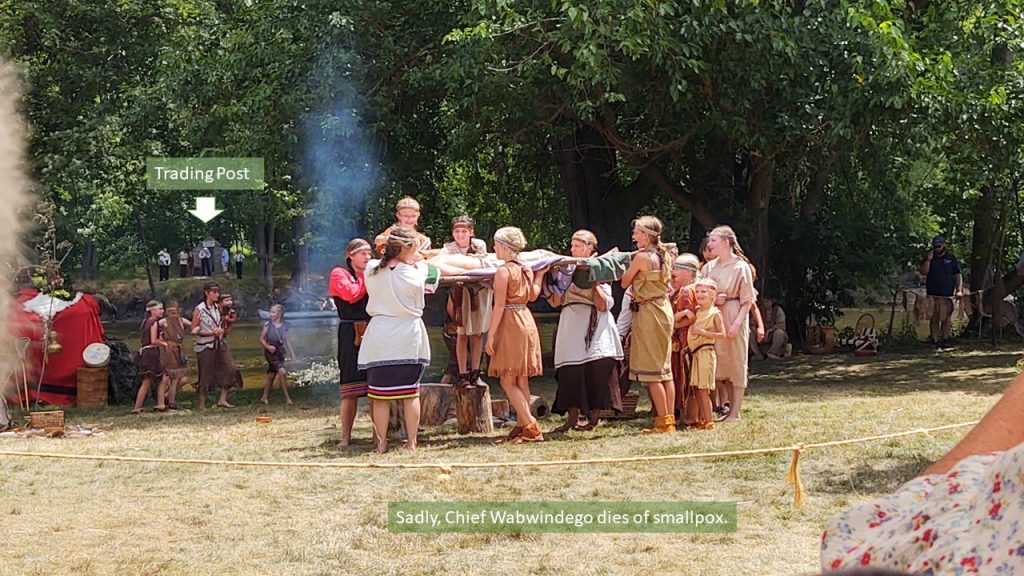
Chief Wabwindego succumbed to the Smallpox illness.
Sadly, Chief Wabwindego passed after being infected by Smallpox. The cast wailed as it was custom to be marked with verbal sadness until the body was buried. It was powerful to witness.
Daniel Marsac Returned
Another canoe came to shore. This time there was a poised woman clad in a bright green dress. She carried a parasol. Her hand waited in the air requesting assistance. Daniel Marsac stepped into the water and lifted the bow of the vessel onto rocky sand. He gallantly offered his hand and escorted this woman into the village. “So, you are well liked and I will be welcomed.” she said as Daniel retrieved her suitcase. I was stunned. Daniel had another woman on his arm? I was so enthralled in the story that I didn’t even click a picture.
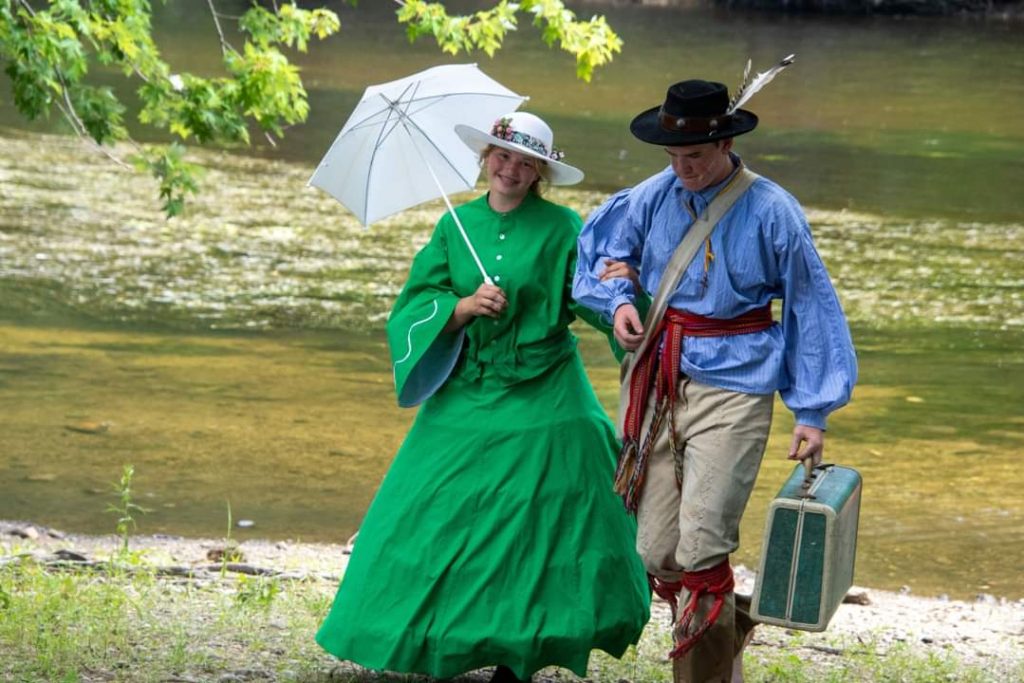
Photo Credit: Bruce Doll
The narrator spoke, “Daniel Marsac had married Colette while living in Detroit. He felt that since his marriage to Jenute hadn’t been registered, it didn’t really count, so he went ahead and married Colette.”
Daniel became a farmer nearby due to the government’s 1836 land agreement. Those who had native children qualified for acreage. Hearing this, I think steam actually puffed out of my ears. Entitlement and selfishness has transcended centuries.
Steamboat John Almy Sinks
As I was adjusting to my disgust over Daniel Marsac’s infidelity and entitlement, the whole cast rushed down by the river’s edge. They were waving and commenting about the steamboat John Almy‘s maiden voyage in1838. However, this riverboat had become stranded at the confluence of the Flat River and Grand River where it eventually sank. The group of actors portrayed their excitement which quickly waned into shock and sadness as they ‘watched’ the events before their eyes.
An Urgent Message for Daniel and Jenute
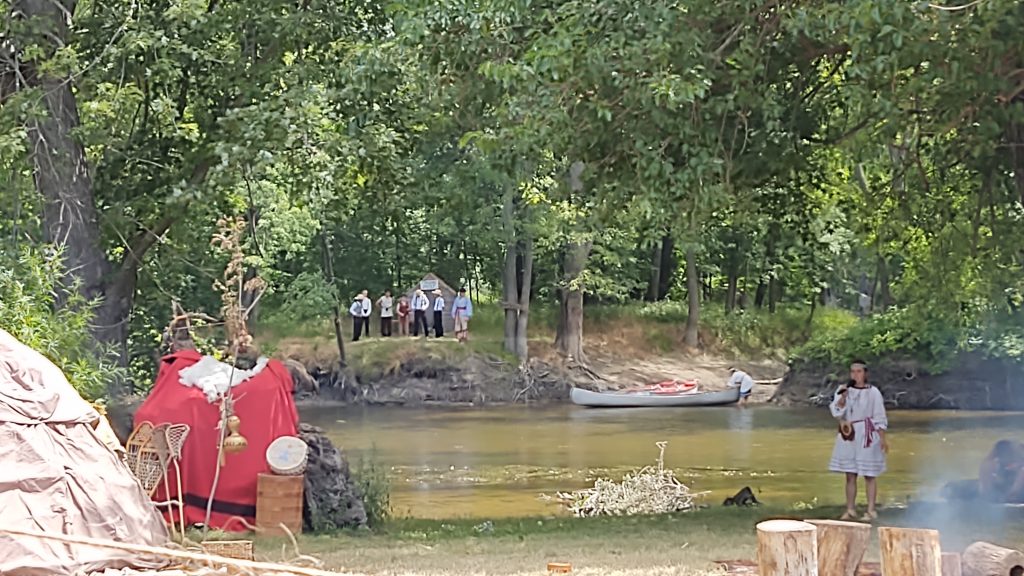
A man approached Daniel at his trading post in 1939. “Your daughter, Marie, had contracted pneumonia and perished four days ago.” He stated with his eyes cast downward. Jenute couldn’t be consoled. She left the camp. Days later Jenute was found frozen in the woods.
With Daniel Marsac now farming land, John Hooker took over operations of Marsac’s trading post. (1846)
Becoming Lowell
Cardboard buildings were fit directly over the log cabins as well as several new structures were placed signifying the growth of Dansville.
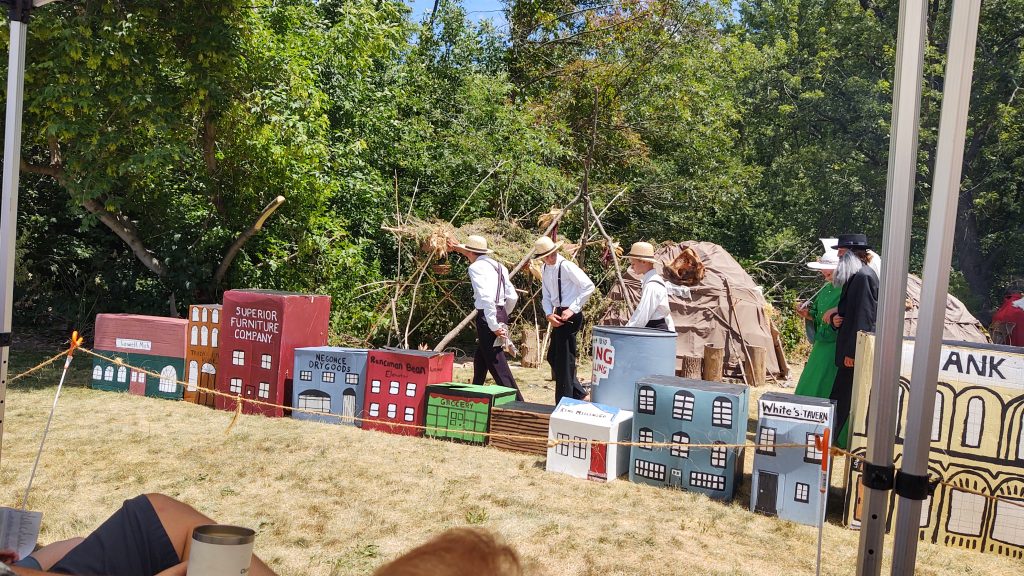
With Daniel Marsac’s legacy falling out of favor, Mrs. Thomas White proposed a new name for “Dansville.” “Lowell would be a good name.” She proclaimed to a friend after visiting Lowell, Massachusetts. “I’ll tell my husband to bring it up at the town meeting.” Mr. White brought the idea to the town board and the motion passed in 1848.
Reservations
With the 1855 Treaty of Washington, natives were given the ‘opportunity’ to choose a plot of land on a reservation. Most relocated, but without natural resources or jobs, many were later forced to sell their land back to the government.
Railroads
Railroads were laid along the river in 1858. Lowell grew exponentially. As the railroads proved to be more efficient, steamboats became obsolete.
Cobmoosa
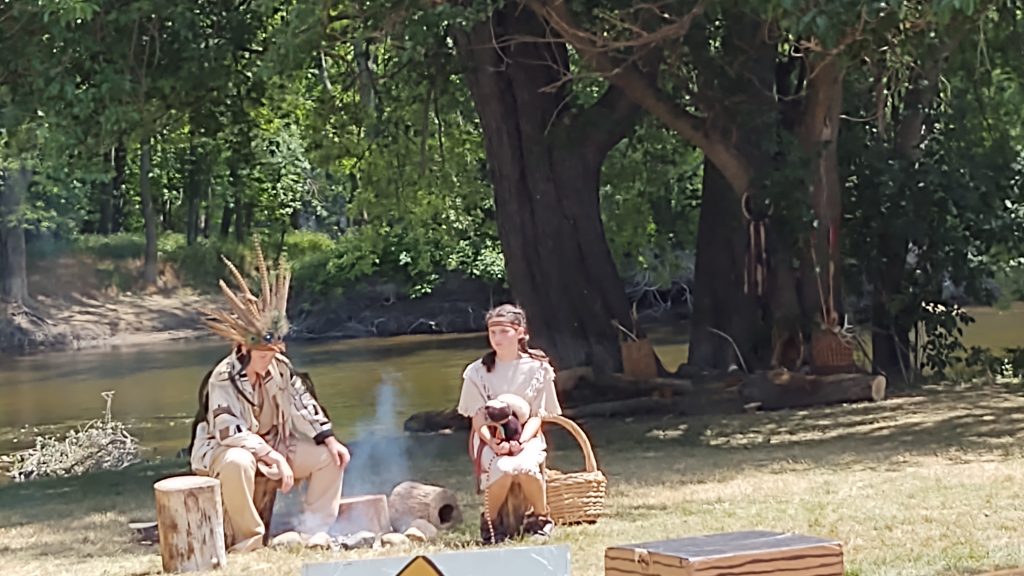
Cobmoosa just couldn’t leave his ancestors’ graves and stayed on the land for many years.
In 1862, Cobmoosa decided to leave his river home and join the others at the reservation.
Applause!
“The River of Time” will stay with me. The story of the four hundred Odawa tribe members, Madame La Framboise, Daniel Marsac and the white settlers delivered a sense of connection and understanding to our ancestors. This well written history, acted out by the area youngsters, was fraught with lessons from which we need to learn. For it is using lessons from our past that we can shape a better future.
Leech Awards
After applauding for each cast member announced by Luanne Kaeb (holding the microphone), she handed the device to Heidi Kaeb Stoller, the author. (She was in the white shirt with colorful stripes.) “Now for the best part, something you’ve all been waiting for . . . The Leech Award!” I was curious and straightened my back for a clearer view of what was to happen next. ‘What could “The Leech Award” entail?’ I wondered.
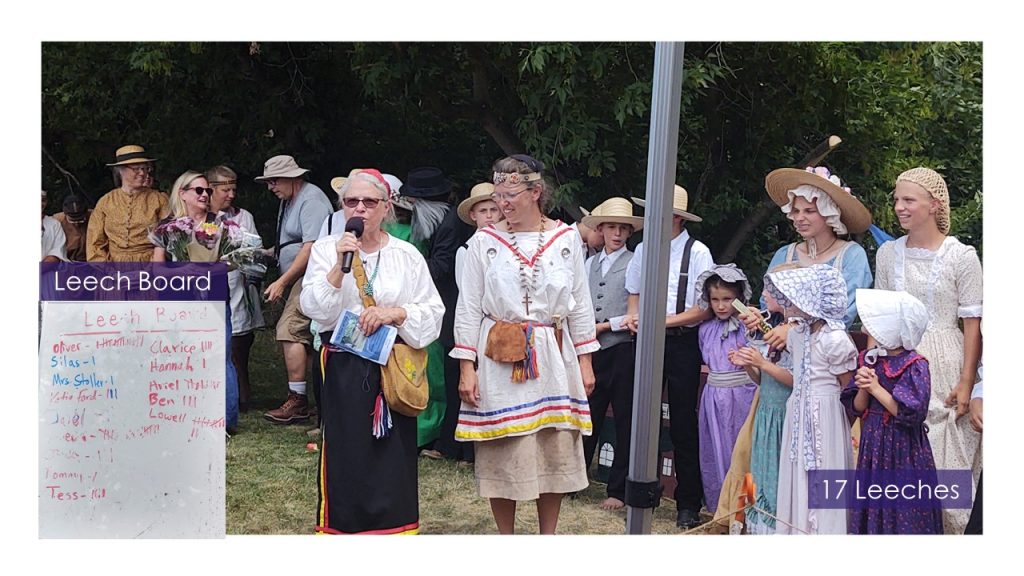
With a week long rehearsal along the Grand River, some kids had gotten leeches.
In order to earn a tally on the “Leech Board” one needed to bring Miss. Heidi their leech.
Heidi would add a mark and then destroy the slimy critter, so it couldn’t be recounted.
Aleda held her hand together tightly hoping to have her name called. (Pictured bottom right) She knew she’d brought a lot of leeches to Miss. Heidi, but would it be enough to win a candy bar? There were three runner ups who each received a treat. Ariel had ten leeches, Lowell brought in twelve and Oliver was graced with sixteen. “Our top contender, with seventeen leeches, goes to Aleda!”
The JOY! Now this was something to behold! A true ‘behind the curtain’ view of “The River of Time” pageant. But, I wanted to know more! I met Heidi, the author of the play and the keeper of the Leech Board, to ask her a few questions.
Behind the Curtain – Heidi Kaeb Stoller
Heidi Kaeb Stoller was still exuding energy after a week long practice and performing in the heat. “The kids started this project last September.” She bubbled. “They’ve learned native crafts such as finger weaving and games. Their leatherwork moccasins will be entered in the fair.”
Did you know that braiding a woman’s hair was the Odawa men’s job? I didn’t either. “Yeah,” Heidi laughed, “We tried to teach the boys. We even had them start by practicing with ropes, but the girls said it wasn’t happening.”
Heidi gestured to the pair of wigwams built by the kids. “Some girls even slept in the wigwams last night. Well, two made it all night. The others came back to the camper.” Her smile was so genuine.
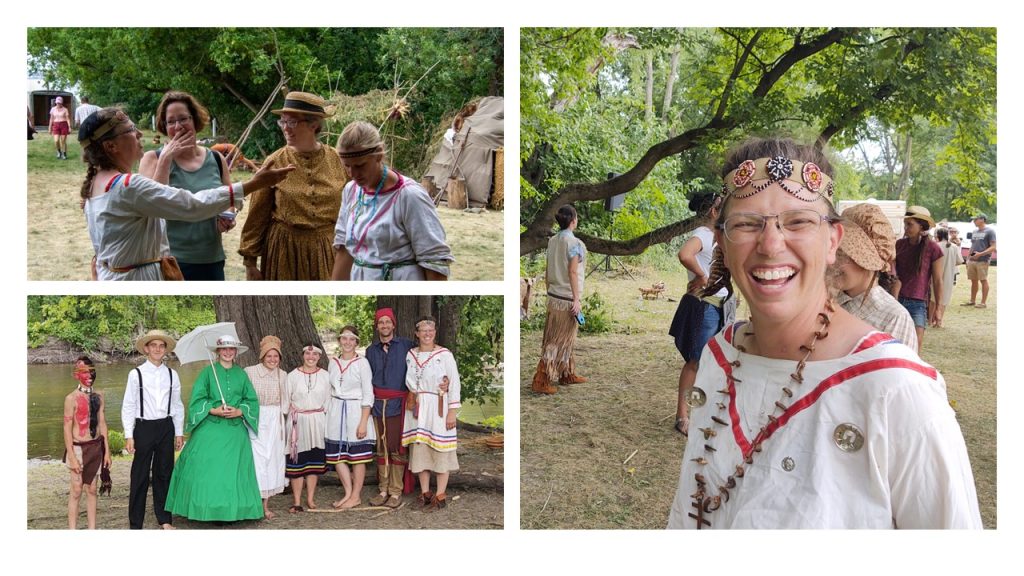
Photo Credit (Top Left): Bruce Doll
Heidi was describing the Leech Board and the rules.
Heidi and her family (bottom left)
When Did Heidi Write This Play?
“My parents had challenged me as a teenager.” Heidi looked skyward recalling the task. “It took a lot of research with reading newspapers. It’s all true!”
Heidi’s Farm Market Connection
“Are you THE ‘Heidi’ from Heidi’s Farm Stand?” I asked. “Yes.” Heidi nodded knowingly. “I was out in the field with my kids and asked myself, ‘Do I want to be a farm stand owner or a mother?’ ” She and her husband had six children present at the show. (pictured above – bottom left) “Now the twins, Ben and Aaron, run the farm stand. They’re my brothers.”
The Kaeb’s Community Connection
“I just love how the third graders travel to Heidi’s Farm Stand every year to experience hands on history! They LOVE it!” I commented referring to my former days as an elementary teacher. Luanne Kaeb, Heidi’s mother, also travels to each elementary school to share the story of ‘Grandma’s Trunk’ for all the second graders. Luanne shares about her grandparents’ immigration and the daily pioneer tasks. Then the students are permitted to practice these chores: a two tub wringer washer, rolling out dough, churning butter, weighing eggs and playing games.
I continued my stream of thought, “Oh, and your family always give our second graders a taste of maple syrup, donuts made over a campfire and pickles at Wittenbach (Nature Center) during the spring. It’s amazing all that your family does for the community!” I complimented.
The Kaebs are also involved with the Lowell Historical Museum. Luanne volunteers regularly and organizes school group visits.
The Kaeb family stretches their philanthropy beyond Lowell. They work as missionaries in various states and countries during the winter months. Their generous gifts of time, energy and insight continue to inspire me and I hope you are inspired, too.
Chuck and Martha Hayden, aka The Viking and Poppins, enjoy going on adventures off the beaten path. They also like to share their explorations with others. The Viking is a retired expedition leader while Poppins is a retired teacher. The two offer independent views of their journeys showcasing places, people, and cultures as they explore the world. Visit and follow them on their website and social media accounts. Website | Facebook | Instagram |YouTube


Leave a Reply